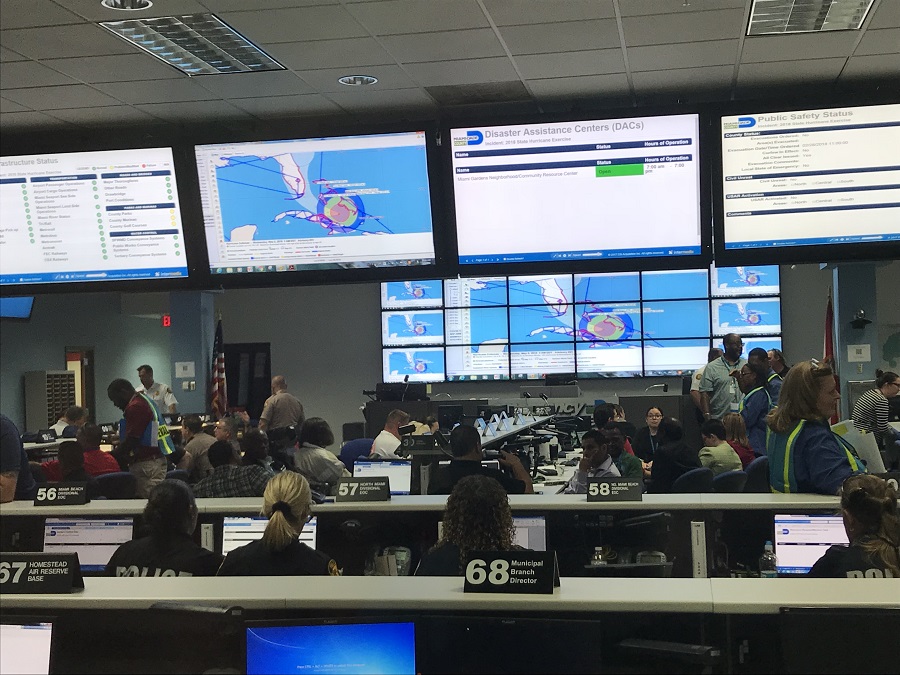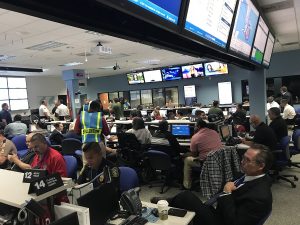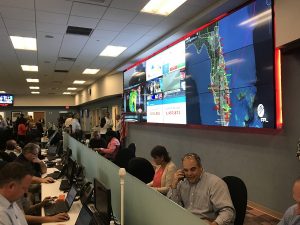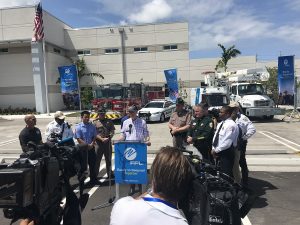

Hurricane simulations are playing out all across the State of Florida ahead of the 2018 hurricane season. Both Miami-Dade County and Florida Power and Light ran their annual storm simulations in early May. The drills are run in real time and last about a week, during which time simulated hurricanes approach and make landfall over the area causing problems to arise that different agencies must work together to solve.
“We try to make it as real as possible,” says David Downey, the Fire Chief of Miami Fire and Rescue. Downey was present in the Emergency Operations Center in Doral Florida as Hurricane Colemen, a simulated category 4 storm, was moving through the area. “We have controllers that are guiding the simulation because we can’t have a real storm,” he says. “They are doing what is called injects, saying ok it’s coming, it’s making landfall, ok we have a problem at this hospital.”
These controllers and observers are often those with experience or individuals who have worked previous storms. Analyzing the outcome of each scenario is critical as it determines if new methods are successful or if new procedures need to be created.“

We always tweak our processes and every time we find new challenges and we try to work through those,” says Downey. “There is never a perfect storm, never a perfect plan so we try to work through these issues to make our plan better.”
While simulated Hurricane Coleman is striking the area, two counties to the north are dealing with Hurricane Cobalt, a simulated category 2 storm crossing from the Gulf Coast and moving over West Palm Beach. This hypothetical storm shows similarities to Hurricanes Wilma and Isbell. A mock weathercast and running totals of power outages are displayed on monitors scattered throughout the Florida Power and Light (FPL) Operations Center make it look and feel like a real storm.
Bill Orlove, a spokesman for FPL, describes the benefits of the drill. “We learn from every drill. Each year we are trying to improve and become better at what we do which is restoring power safely and quickly after a storm passes, ” Orlove said. In addition to the drills FPL is also making improvements in its infrastructure and coming up with new technology to help limit power outages or even eliminate them entirely.
Hurricane Irma put those improvements to the test in the 2017 season and they appeared to be paying off with the recovery. “We saw that our underground system performed better than our overhead system because (Irma) was a wind storm”, said Orlove. From those lessons learned they now have a pilot program in place which will look into undergrounding power segments or determine how it can be done.

Communicating between different agencies is a critical part of storm recovery and is something that these drills help put into practice. Florida Governor Rick Scott has had a lot of experience dealing with inter-agency communication, especially last hurricane season. Governor Scott was considered to be a leader on the front lines of the Irma recovery and was a guest at FPL storm week. “People talked together and to each other and they worked together. That’s why this state did so well during Irma,” Governor Scott said at a press conference outside the Operations Center.
Even though the simulated storms were different, the message was the same at both the Emergency Operations Center in Miami-Dade and the FPL Operations Center: be prepared. These two locations are being prepared ahead of hurricane season it and they want the public to do it too.
The 2018 Atlantic Hurricane Season begins June 1. It is currently forecast to have an above normal number of storms.